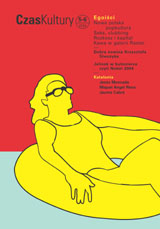Seks clubbingu: imprezowanie a konflikt seksualności
The Sex of Clubbing: Partying and the Sexuality Conflict
Author(s): Paweł Leszkowicz, Tomasz KitlińskiSubject(s): Cultural Essay, Political Essay, Societal Essay
Published by: Stowarzyszenie Czasu Kultury
Summary/Abstract: The popularity of lesbian/gay clubs Being European vs. the Polish national homophobia Social pluralism in lesbian/gay clubs The local hetero-matrix The monotonous one-dimensional erotic capacity of entertainment venues from the communist era in Poland has been replaced by a diversity of clubs since the boom of democracy. Lesbian and gay clubs, which could not have publicly existed under the previous political system, are now enjoying popularity in heterosexual society. This would be fantastic if it was all about tolerance in the name of which all types of sexuality mingle for the pleasure of having fun together. “Let all the different couples, dance, kiss and love, get drunk and intoxicated side by side”, is the ostensible slogan of Paweł Leszkowicz and Tomek Kitliński, although they are aware that these words have a utopian resonance. The brutal Polish reality shows that our country still has a long way to go if it wants to achieve the openness found in Western Europe. The fights started in gay clubs by homophobic thugs and the persecution that leads to the closing of these venues clubs and bars embarrassingly prove the point. So it is not surprising that “the young generation is torn between being European and typically Polish (i.e. homophobic). Neither is it surprising that different sexual orientation is still a matter of significance and inequality in the face of the law”. Fortunately, it is not only the aggressive “real” men who come to these clubs to have a good time by, at best, ridiculing or abusing gays and lesbians. The clientele often includes heterosexuals without excess testosterone levels who come to gay clubs simply to have a good time. For example, heterosexual women enjoy these places since they are free of the sexist atmosphere that they often encounter in the so-called “normal” venues. This makes lesbian and gay clubs an oasis for a diversity of guests and thus reflects real social pluralism. We must, however, remember that this pluralism is still being effectively limited by the “agents of the hetero-matrix”. The authors note that if “you kiss a partner of the same gender in a heterosexual venue you will most certainly get your face smashed in”. So when will this image naturally fuse into that of a night out with tolerant heterosexuals?
Journal: Czas Kultury
- Issue Year: 2004
- Issue No: 05-06
- Page Range: 40-50
- Page Count: 11
- Language: Polish
- Content File-PDF

